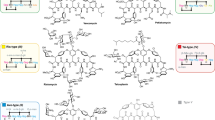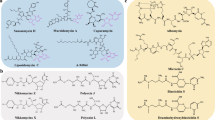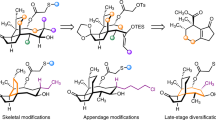Abstract
In the search for new efficacious antibiotics, biosynthetic engineering offers attractive opportunities to introduce minor alterations to antibiotic structures that may overcome resistance. Dbv29, a flavin-containing oxidase, catalyzes the four-electron oxidation of a vancomycin-like glycopeptide to yield A40926. Structural and biochemical examination of Dbv29 now provides insights into residues that govern flavinylation and activity, protein conformation and reaction mechanism. In particular, the serendipitous discovery of a reaction intermediate in the crystal structure led us to identify an unexpected opportunity to intercept the normal enzyme mechanism at two different points to create new teicoplanin analogs. Using this method, we synthesized families of antibiotic analogs with amidated and aminated lipid chains, some of which showed marked potency and efficacy against multidrug resistant pathogens. This method offers a new strategy for the development of chemical diversity to combat antibacterial resistance.
This is a preview of subscription content, access via your institution
Access options
Subscribe to this journal
Receive 12 print issues and online access
$259.00 per year
only $21.58 per issue
Buy this article
- Purchase on Springer Link
- Instant access to full article PDF
Prices may be subject to local taxes which are calculated during checkout




Similar content being viewed by others
References
Murray, B.E. Vancomycin-resistant enterococcal infections. N. Engl. J. Med. 342, 710–721 (2000).
Rice, L.B. Antimicrobial resistance in gram-positive bacteria. Am. J. Infect. Control 34, S11–S19 (2006).
Fischbach, M.A. & Walsh, C.T. Antibiotics for energin pathogens. Science 325, 1089–1093 (2009).
Payne, D.J., Gwynn, M.N., Holmes, D.J. & Pompliano, D.L. Drugs for bad bugs: confronting the challenges of antibacterial discovery. Nat. Rev. Drug Discov. 6, 29–40 (2007).
Silver, L.L. Multi-targeting by monotherapeutic antibacterials. Nat. Rev. Drug Discov. 6, 41–55 (2007).
Donadio, S. & Sosio, M. Biosynthesis of glycopeptides: prospects for improved antibacterials. Curr. Top. Med. Chem. 8, 654–666 (2008).
Kim, A., Kuti, J.L. & Nicolau, D.P. Review of dalbavancin, a novel semisynthetic lipoglycopeptide. Expert Opin. Investig. Drugs 16, 717–733 (2007).
Ho, J.Y. et al. Glycopeptide biosynthesis: Dbv21/Orf2 from dbv/tcp gene clusters are N-Ac-Glm teicoplanin pseudoaglycone deacetylases and Orf15 from cep gene cluster is a Glc-1-P thymidyltransferase. J. Am. Chem. Soc. 128, 13694–13695 (2006).
Li, Y.S. et al. A unique flavin mononucleotide-linked primary alcohol oxidase for glycopeptide A40926 maturation. J. Am. Chem. Soc. 129, 13384–13385 (2007).
Campbell, R.E., Mosimann, S.C., Rijn, I.D., Tanner, M.E. & Strynadka, N.C. The first structure of UDP-glucose dehydrogenase reveals the catalytic residues necessary for the two-fold oxidation. Biochemistry 39, 7012–7023 (2000).
Leskovac, V., Trivić, S., Wohlfahrt, G., Kandrac, J. & Pericin, D. Glucose oxidase from Aspergillus niger: the mechanism of action with molecular oxygen, quinones, and one-electron acceptors. Int. J. Biochem. Cell Biol. 37, 731–750 (2005).
Snook, C.F., Tipton, P. & Beamer, L. Crystal structure of GDP-mannose dehydrogenase: a key enzyme of alginate biosynthesis in P. aeruginosa. Biochemistry 42, 4658–4668 (2003).
Chan, H.C. et al. Regioselective deacetylation based on teicoplanin-complexed Orf2* crystal structures. Mol. Biosyst. 7, 1224–1231 (2011).
Li, T.L. et al. Biosynthetic gene cluster of the glycopeptide antibiotic teicoplanin: characterization of two glycosyltransferases and the key acyltransferase. Chem. Biol. 11, 107–119 (2004).
Alexeev, I., Sultana, A., Mäntsälä, P., Niemi, J. & Schneider, G. Aclacinomycin oxidoreductase (AknOx) from the biosynthetic pathway of the antibiotic aclacinomycin is an unusual flavoenzyme with a dual active site. Proc. Natl. Acad. Sci. USA 104, 6170–6175 (2007).
Dym, O. & Eisenberg, D. Sequence-structure analysis of FAD-containing proteins. Protein Sci. 10, 1712–1728 (2001).
Huang, C.H. et al. Crystal structure of glucooligosaccharide oxidase from Acremonium strictum: a novel flavinylation of 6-S-cysteinyl, 8alpha-N1-histidyl FAD. J. Biol. Chem. 280, 38831–38838 (2005).
Whittaker, J.W. Free radical catalysis by galactose oxidase. Chem. Rev. 103, 2347–2363 (2003).
Winkler, A. et al. A concerted mechanism for berberine bridge enzyme. Nat. Chem. Biol. 4, 739–741 (2008).
Borch, R.F., Bernstein, M.D. & Durstlb, H.D. The cyanohydridoborate anion as a selective reducing agent. J. Am. Chem. Soc. 93, 2897–2904 (1971).
Koteva, K. et al. A vancomycin photoprobe identifies the histidine kinase VanSsc as a vancomycin receptor. Nat. Chem. Biol. 6, 327–329 (2010).
Higgins, D.L. et al. Telavancin, a multifunctional lipoglycopeptide, disrupts both cell wall synthesis and cell membrane integrity in methicillin-resistant Staphylococcus aureus. Antimicrob. Agents Chemother. 49, 1127–1134 (2005).
Bailey, J. & Summers, K.M. Dalbavancin: a new lipoglycopeptide antibiotic. Am. J. Health Syst. Pharm. 65, 599–610 (2008).
Linden, P.K. Vancomycin resistance: are there better glycopeptides coming? Expert Rev. Anti Infect. Ther. 6, 917–928 (2008).
Roecker, A.M. & Pope, S.D. Dalbavancin: a lipoglycopeptide antibacterial for Gram-positive infections. Expert Opin. Pharmacother. 9, 1745–1754 (2008).
Otwinowski, Z. & Minor, W. in Methods in enzymology, macromolecular crystallography, part A Vol. 276 (eds. Carter, C.W. Jr & Sweet, R.M.) 307–326 (Academic Press, 1997).
Kantardjieff, K.A. & Rupp, B. Matthews coefficient probabilities: Improved estimates for unit cell contents of proteins, DNA, and protein-nucleic acid complex crystals. Protein Sci. 12, 1865–1871 (2003).
Vagin, A. & Teplyakov, A. MOLREP: an automated program for molecular replacement. J. Appl. Cryst. 30, 1022–1025 (1997).
McRee, D.E. XtalView/Xfit—a versatile program for manipulating atomic coordinates and electron density. J. Struct. Biol. 125, 156–165 (1999).
Brünger, A.T. et al. Crystallography & NMR system: A new software suite for macromolecular structure determination. Acta Crystallogr D 54, 905–921 (1998).
Murshudov, G.N., Vagin, A.A. & Dodson, E.J. Refinement of macromolecular structures by the maximum-likelihood method. Acta Crystallogr. D 53, 240–255 (1997).
Schuck, P. Size distribution analysis of macromolecules by sedimentation velocity ultracentrifugation and Lamm equation modeling. Biophys. J. 78, 1606–1619 (2000).
Acknowledgements
The research was supported by the National Science Council of Taiwan (grants 96-2628-B-001-026-MY3 and 98-2311-B-001-014-MY3 to T.-L.L.) and Academia Sinica intramural funding. X-ray diffraction was carried out at the Protein Crystallography Facility at the National Synchrotron Radiation Research Center, supported by the National Research Program for Genomic Medicine and the National Science Council of Taiwan. We thank C.-Y. Wu (Academia Sinica) for providing 5-azide pentylamine.
Author information
Authors and Affiliations
Contributions
T.-L.L. designed research; Y.-C.L. solved the structures; H.-C.C. and C.-C.C. helped refinement; Y.-S.L., S.-Y.L., C.-J.H., Y.-T.H. and G.-H.C. performed biochemical experiments; Y.-H.C. and Y.-C.L. performed analytical ultracentrifuge analysis; L.-J.H. performed animal tests. T.-L.L. and M.-D.T. provided supervision; T.-L.L. and M.-D.T. wrote the paper.
Corresponding author
Ethics declarations
Competing interests
The authors declare no competing financial interests.
Supplementary information
Supplementary Text and Figures
Supplementary Methods, Supplementary Figures 1–19 and Supplementary Tables 1–4 (PDF 6641 kb)
Rights and permissions
About this article
Cite this article
Liu, YC., Li, YS., Lyu, SY. et al. Interception of teicoplanin oxidation intermediates yields new antimicrobial scaffolds. Nat Chem Biol 7, 304–309 (2011). https://doi.org/10.1038/nchembio.556
Received:
Accepted:
Published:
Issue Date:
DOI: https://doi.org/10.1038/nchembio.556
This article is cited by
-
Production enhancement of the glycopeptide antibiotic A40926 by an engineered Nonomuraea gerenzanensis strain
Biotechnology Letters (2022)
-
Addendum: Interception of teicoplanin oxidation intermediates yields new antimicrobial scaffolds
Nature Chemical Biology (2015)
-
The substrate tolerance of alcohol oxidases
Applied Microbiology and Biotechnology (2015)
-
Tirandamycin biosynthesis is mediated by co-dependent oxidative enzymes
Nature Chemistry (2011)



